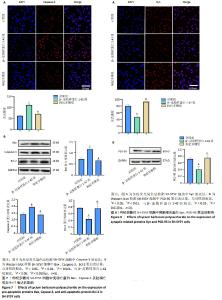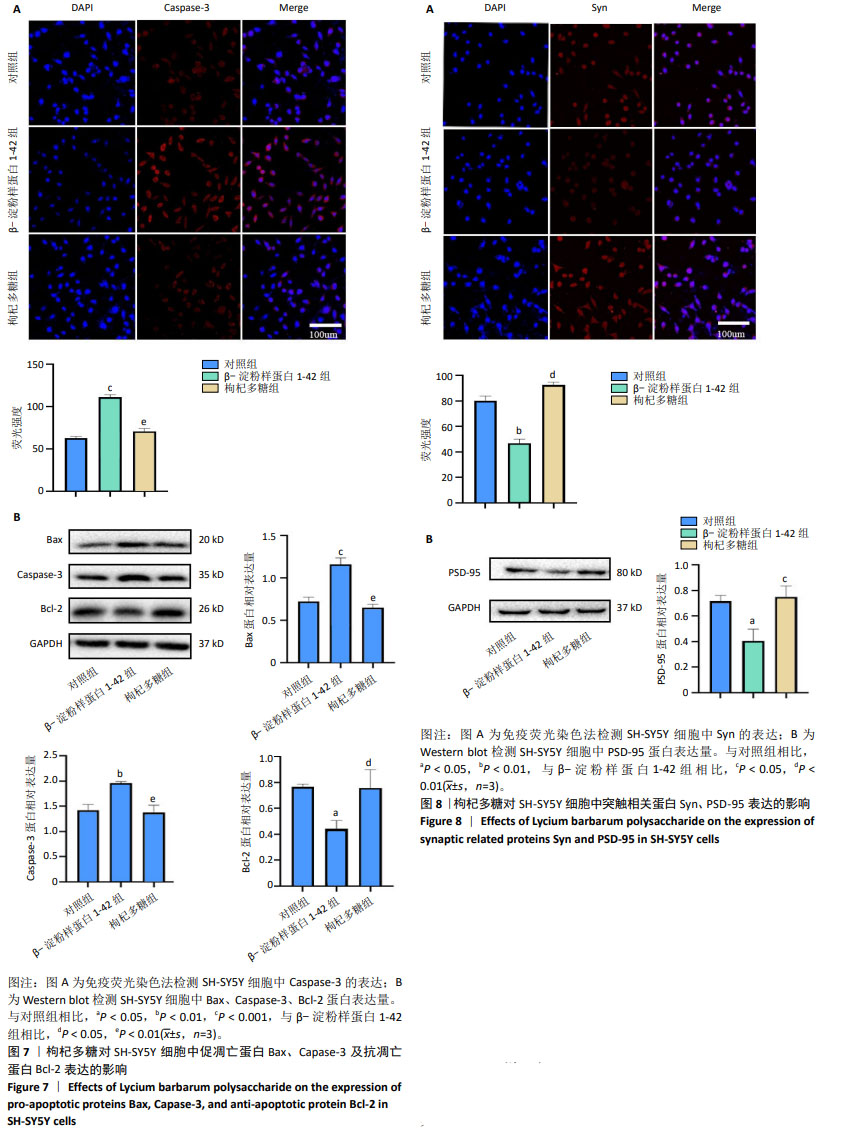Chinese Journal of Tissue Engineering Research ›› 2025, Vol. 29 ›› Issue (31): 6688-6696.doi: 10.12307/2025.545
Previous Articles Next Articles
Lycium barbarum polysaccharide intervenes in SH-SY5Y cell injury induced by beta-amyloid protein 1-42: protective effect of mitochondrial autophagy
Su Qin1, 2, Jia Siwei1, 2, Guo Minfang2, Meng Tao2, Li Yanbing1, 2, Mu Bingtao2, Song Lijuan1, Ma Cungen1, 2, Yu Jiezhong1, 2, 3
- 1Neurobiology Research Center of Shanxi University of Chinese Medicine/Key Research Laboratory of State Administration of Traditional Chinese Medicine for Treatment of Multiple Sclerosis with Replenishing Qi and Huoxue Method, Jinzhong 030619, Shanxi Province, China; 2Institute of Brain Science of Shanxi Datong University/Molecular Cellular Immunology, Datong City Key Laboratory, Datong 037009, Shanxi Province, China; 3Datong Fifth People’s Hospital, Datong 037009, Shanxi Province, China
-
Received:2024-06-27Accepted:2024-08-31Online:2025-11-08Published:2025-02-24 -
Contact:Yu Jiezhong, Professor, Doctoral supervisor, Neurobiology Research Center of Shanxi University of Chinese Medicine/Key Research Laboratory of State Administration of Traditional Chinese Medicine for Treatment of Multiple Sclerosis with Replenishing Qi and Huoxue Method, Jinzhong 030619, Shanxi Province, China; Institute of Brain Science of Shanxi Datong University/Molecular Cellular Immunology, Datong City Key Laboratory, Datong 037009, Shanxi Province, China; Datong Fifth People’s Hospital, Datong 037009, Shanxi Province, China; Co-corresponding author: Ma Cungen, Doctoral supervisor, Neurobiology Research Center of Shanxi University of Chinese Medicine/Key Research Laboratory of State Administration of Traditional Chinese Medicine for Treatment of Multiple Sclerosis with Replenishing Qi and Huoxue Method, Jinzhong 030619, Shanxi Province, China; Institute of Brain Science of Shanxi Datong University/Molecular Cellular Immunology, Datong City Key Laboratory, Datong 037009, Shanxi Province, China -
About author:Su Qin, Master candidate, Neurobiology Research Center of Shanxi University of Chinese Medicine/Key Research Laboratory of State Administration of Traditional Chinese Medicine for Treatment of Multiple Sclerosis with Replenishing Qi and Huoxue Method, Jinzhong 030619, Shanxi Province, China; Institute of Brain Science of Shanxi Datong University/Molecular Cellular Immunology, Datong City Key Laboratory, Datong 037009, Shanxi Province, China; Jia Siwei, Master candidate, Neurobiology Research Center of Shanxi University of Chinese Medicine/Key Research Laboratory of State Administration of Traditional Chinese Medicine for Treatment of Multiple Sclerosis with Replenishing Qi and Huoxue Method, Jinzhong 030619, Shanxi Province, China; Institute of Brain Science of Shanxi Datong University/Molecular Cellular Immunology, Datong City Key Laboratory, Datong 037009, Shanxi Province, China Su Qin and Jia Siwei contributed equally to this article. -
Supported by:Shanxi Basic Research Program, No. 202303021211244 (to YJZ); Shanxi 2022 "Four Batches" Science and Technology Innovation Program, No. 2022XM33 (to YJZ); Shanxi Traditional Chinese Medicine Research Project, No. 2023ZYYB2042 (to YJZ); State Administration of Traditional Chinese Medicine Research Project, No. 2023ZYYDA2038 (to MCG); 2022 Science and Technology Innovation Team Project of Shanxi University of Chinese Medicine, No. 2022TD2010 (to MCG); The 2022 TCM Research Project Plan of Shanxi Provincial Health Commission, No. 2022ZYYC090 (to MCG); Basic Research Plan Project of Shanxi Province, No. 20210302123476 (to GMF); Platform Plan Project of Datong City, No. 2022082 (to YJZ); Research Project Plan Project of Shanxi Provincial Health Commission, No. 2021168 (to YJZ); Shanxi Provincial Administration of Traditional Chinese Medicine Research Project, No. 2023ZYYB2042 (to YJZ); Shanxi Provincial Key Research Office of Traditional Chinese Medicine, No. zyyyjs2024027 (to YJZ)
CLC Number:
Cite this article
Su Qin, Jia Siwei, Guo Minfang, Meng Tao, Li Yanbing, Mu Bingtao, Song Lijuan, Ma Cungen, Yu Jiezhong. Lycium barbarum polysaccharide intervenes in SH-SY5Y cell injury induced by beta-amyloid protein 1-42: protective effect of mitochondrial autophagy[J]. Chinese Journal of Tissue Engineering Research, 2025, 29(31): 6688-6696.
share this article
Add to citation manager EndNote|Reference Manager|ProCite|BibTeX|RefWorks
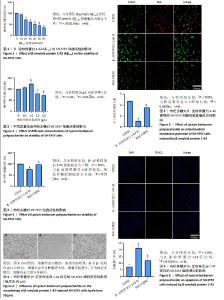
2.1 β-淀粉样蛋白1-42最佳干预浓度的确定 如图1所示,用10 μmol/L β-淀粉样蛋白1-42处理时,细胞活力有所下降,但与对照组(0 μmol/L β-淀粉样蛋白1-42)比较无明显差异。用20 μmol/L β-淀粉样蛋白1-42处理时,细胞活力明显下降,与对照组比较差异有显著性意义(P < 0.001)。当β-淀粉样蛋白1-42浓度增加至60 μmol/L时,细胞活力继续下降,与对照组比较差异有显著性意义(P < 0.001)。后续实验中选择β-淀粉样蛋白1-42溶液浓度为20 μmol/L。 2.2 枸杞多糖药物浓度的确定 如图2所示,枸杞多糖质量浓度在0.5 g/L时,细胞活力有所提高,但与对照组(0 g/L枸杞多糖)相比无明显差异。枸杞多糖质量浓度在1 g/L时,与对照组相比细胞活力显著提高(P < 0.01),但当枸杞多糖质量浓度大于1 g/L时,与对照组相比细胞活力则降低(P < 0.05)。后续实验选择枸杞多糖质量浓度为1 g/L。 2.3 枸杞多糖减轻β-淀粉样蛋白1-42诱导的SH-SY5Y细胞损伤 CCK-8结果显示,与对照组比较,β-淀粉样蛋白1-42组细胞活力下降(P < 0.05);与β-淀粉样蛋白1-42组比较,枸杞多糖组细胞活力增加(图3,P < 0.01)。 2.4 枸杞多糖对β-淀粉样蛋白1-42诱导的SH-SY5Y细胞形态的影响 显微镜下观察发现,对照组 SH-SY5Y细胞形态正常,突触明显,生长状态好;β-淀粉样蛋白1-42组SH-SY5Y细胞胞体变肥大,细胞突触收缩,边缘模糊;枸杞多糖组细胞形态与对照组相似,大部分呈梭形,突起明显,见图4。 2.5 枸杞多糖提高β-淀粉样蛋白1-42诱导的SH-SY5Y细胞线粒体膜电位水平 JC-1是一种阳离子染料,能在线粒体内聚集。用JC-1 试剂盒可直接检测枸杞多糖对β-淀粉样蛋白1-42 诱导的SH-SY5Y细胞线粒体膜电位水平,见图5,与对照组相比,β-淀粉样蛋白1-42组的红/绿荧光强度比值明显下降(P < 0.001),线粒体膜电位水平降低;与β-淀粉样蛋白1-42组相比,枸杞多糖组的红/绿荧光强度比值明显上升(P < 0.01),线粒体膜电位水平提高,结果说明枸杞多糖可改善β-淀粉样蛋白1-42诱导的细胞线粒体膜电位降低,减少细胞凋亡,对细胞有保护作用。 2.6 枸杞多糖抑制β-淀粉样蛋白1-42诱导的SH-SY5Y细胞凋亡 TUNEL试剂盒检测细胞凋亡情况,见图6。与对照组比较,β-淀粉样蛋白1-42组细胞凋亡率上升(P < 0.01);与β-淀粉样蛋白1-42组比较,枸杞多糖组细胞凋亡率下降(P < 0.01)。免疫荧光结果显示,与对照组比较,β-淀粉样蛋白1-42组Caspase-3靶标的表达提高(P < 0.01);与β-淀粉样蛋白1-42组比较,枸杞多糖组Caspase-3靶标的表达下降(P < 0.01),见图7A。Western blot结果显示,与对照组比较,β-淀粉样蛋白1-42组Caspase-3、Bax蛋白表达上升(P < 0.05,P < 0.01),Bcl-2蛋白表达下降(P < 0.05);与 β-淀粉样蛋白1-42组比较,枸杞多糖组Caspase-3、Bax蛋白表达显著下降(P < 0.05,P < 0.05), Bcl-2蛋白表达上升 (P < 0.05),见图7B。以上结果表明,枸杞多糖可抑制β-淀粉样蛋白1-42诱导的SH-SY5Y细胞凋亡,对细胞有保护作用。 "
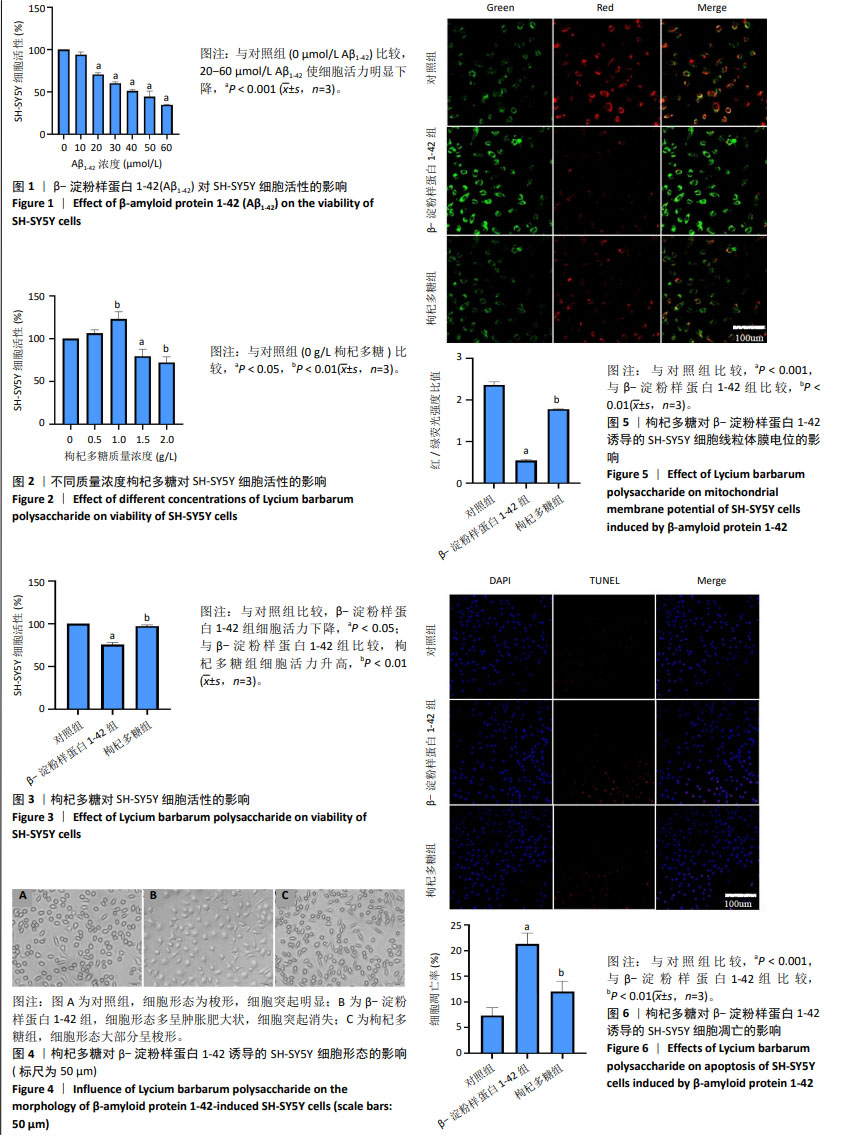
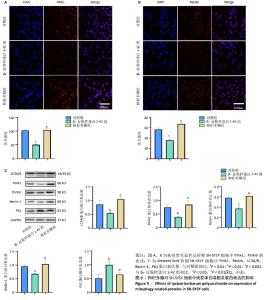
2.8 枸杞多糖对线粒体自噬相关蛋白的调控 免疫荧光结果显示,与对照组比较,β-淀粉样蛋白1-42组Pink1、Parkin表达显著下降(P < 0.05),与β-淀粉样蛋白1-42组比较,枸杞多糖组Pink1、Parkin表达显著提高(P < 0.05),见图9A,B。Western blot结果显示,与对照组比较,β-淀粉样蛋白1-42组Pink1、Parkin、LC3A/B、Beclin-1蛋白表达显著下降(P < 0.05),P62蛋白表达显著提高(P < 0.05);与β-淀粉样蛋白1-42组比较,枸杞多糖组Pink1、Parkin、LC3A/B、Beclin-1蛋白表达显著提高(P < 0.05),P62蛋白表达显著下降(P < 0.05),见图9C。上述结果表明,枸杞多糖可能通过调控线粒体自噬来抑制β-淀粉样蛋白1-42诱导的SH-SY5Y细胞损伤。"
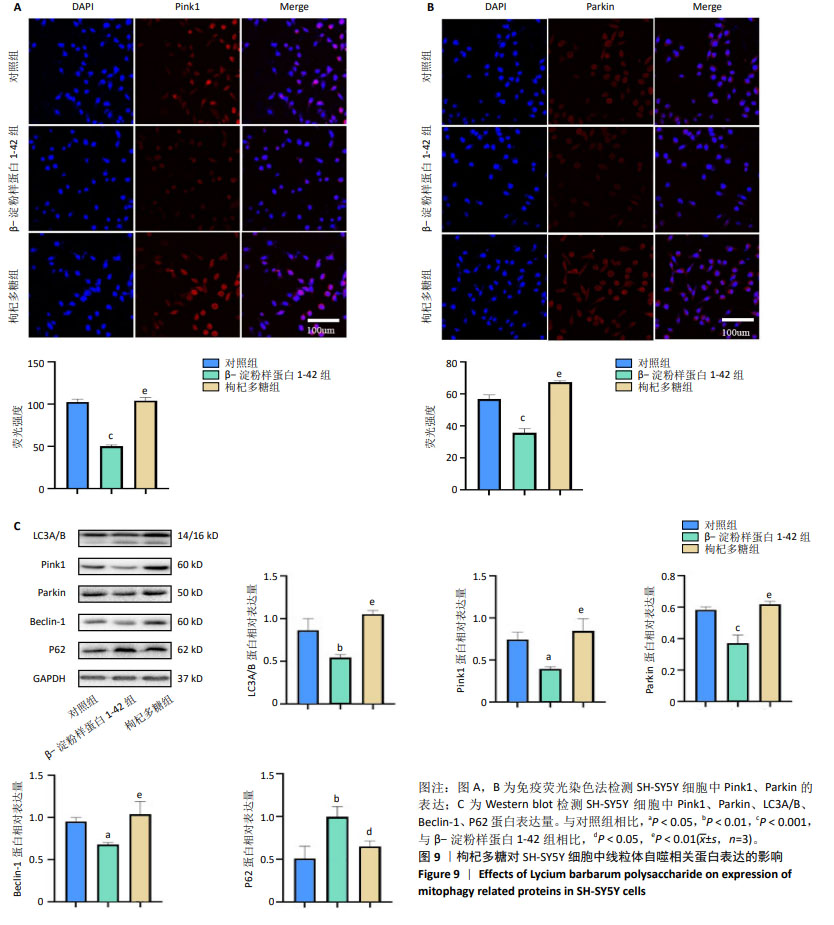
| [1] LU Y, LI Z, ZHANG S, et al. Cellular mitophagy: Mechanism, roles in diseases and small molecule pharmacological regulation. Theranostics. 2023;13(2):736-766. [2] REISS AB, GULKAROV S, JACOB B, et al. Mitochondria in Alzheimer’s Disease Pathogenesis. Life (Basel). 2024 ;14(2):196. [3] PRADEEPKIRAN JA, RAWAT P, REDDY AP, et al. DDQ anti-aging properties expressed with improved mitophagy in mutant tau HT22 neuronal cells. Mitochondrion. 2024;75:101843. [4] MARY A, EYSERT F, CHECLER F, et al. Mitophagy in Alzheimer’s disease: Molecular defects and therapeutic approaches. Mol Psychiatry. 2023; 28(1):202-216. [5] PRADEEPKIRAN JA, BAIG J, SEMAN A, et al. Mitochondria in Aging and Alzheimer’s Disease: Focus on Mitophagy. Neuroscientist. 2024; 30(4):440-457. [6] LI J, LI M, GE Y, et al. β-amyloid protein induces mitophagy-dependent ferroptosis through the CD36/PINK/PARKIN pathway leading to blood-brain barrier destruction in Alzheimer’s disease. Cell Biosci. 2022;12(1):69. [7] ZHAO N, ZHANG X, LI B, et al. Treadmill Exercise Improves PINK1/Parkin-Mediated Mitophagy Activity Against Alzheimer’s Disease Pathologies by Upregulated SIRT1-FOXO1/3 Axis in APP/PS1 Mice. Mol Neurobiol. 2023;60(1):277-291. [8] ZHOU Y, ZHAO Q, ZHANG Y, et al. A new andrographolide derivative ADA targeting SIRT3-FOXO3a signaling mitigates cognitive impairment by activating mitophagy and inhibiting neuroinflammation in Apoe4 mice. Phytomedicine. 2024;124:155298. [9] WANG N, YANG J, CHEN R, et al. Ginsenoside Rg1 ameliorates Alzheimer’s disease pathology via restoring mitophagy. J Ginseng Res. 2023;47(3):448-457. [10] WANG Y, SONG C, YIN G, et al. Alleviation of behavioral deficits, amyloid-β deposition, and mitochondrial structure damage associated with mitophagy upregulation in AD animal models via AAV9-IGF-1 treatment. Brain Res. 2024;1827:148743. [11] CEN X, CHEN Y, XU X, et al. Pharmacological targeting of MCL-1 promotes mitophagy and improves disease pathologies in an Alzheimer’s disease mouse model. Nat Commun. 2020;11(1):5731. [12] JIANG SJ, XIAO X, LI J, et al. Lycium barbarum polysaccharide-glycoprotein ameliorates ionizing radiation-induced epithelial injury by regulating oxidative stress and ferroptosis via the Nrf2 pathway. Free Radic Biol Med. 2023;204:84-94. [13] YANG Y, YU L, ZHU T, et al. Neuroprotective effects of Lycium barbarum polysaccharide on light-induced oxidative stress and mitochondrial damage via the Nrf2/HO-1 pathway in mouse hippocampal neurons. Int J Biol Macromol. 2023;251:126315. [14] GAO J, WANG Y, HAN R, et al. Elevated KDM4D Expression in Pterygium: Impact and Potential Inhibition by Lycium Barbarum Polysaccharide. J Ocul Pharmacol Ther. 2024;40(3):181-188. [15] FEDELE E. Anti-Amyloid Therapies for Alzheimer’s Disease and the Amyloid Cascade Hypothesis. Int J Mol Sci. 2023;24(19):14499. [16] FANG EF, HOU Y, PALIKARAS K, et al. Mitophagy inhibits amyloid-β and tau pathology and reverses cognitive deficits in models of Alzheimer’s disease. Nat Neurosci. 2019;22(3):401-412. [17] PIRES M, REGO AC. Apoe4 and Alzheimer’s Disease Pathogenesis-Mitochondrial Deregulation and Targeted Therapeutic Strategies. Int J Mol Sci. 2023;24(1):778. [18] ZENG K, YU X, MAHAMAN YAR, et al. Defective mitophagy and the etiopathogenesis of Alzheimer’s disease. Transl Neurodegener. 2022; 11(1):32. [19] ZHU S, LI X, DANG B, et al. Lycium Barbarum polysaccharide protects HaCaT cells from PM2.5-induced apoptosis via inhibiting oxidative stress, ER stress and autophagy. Redox Rep. 2022;27(1):32-44. [20] WANG J, GAO H, XIE Y, et al. Lycium barbarum polysaccharide alleviates dextran sodium sulfate-induced inflammatory bowel disease by regulating M1/M2 macrophage polarization via the STAT1 and STAT6 pathways. Front Pharmacol. 2023;14:1044576. [21] LAI S, LIU C, LIU C, et al. Lycium barbarum polysaccharide-glycoprotein promotes osteogenesis in hPDLSCs via ERK activation. Oral Dis. 2023; 29(8):3503-3513. [22] LAKSHMANAN Y, WONG FSY, SO KF, et al. Potential role of Lycium barbarum polysaccharides in glaucoma management: evidence from preclinical in vivo studies. Neural Regen Res. 2023;18(12):2623-2632. [23] 叶红霞,贺颖西,齐妍强,等.枸杞多糖对阿尔茨海默病合并2型糖尿病小鼠学习记忆能力及脑内Tau蛋白磷酸化水平的影响[J].石河子大学学报(自然科学版),2023,41(3):360-366. [24] 王玉银,魏文悦,郭敏芳,等.枸杞多糖通过抑制TLR4/NF-κB信号通路促进LPS诱导的BV2小胶质细胞M2型极化[J].细胞与分子免疫学杂志,2021,37(12):1066-1072. [25] LI R, DUAN W, FENG T, et al. Lycium barbarum polysaccharide inhibits ischemia-induced autophagy by promoting the biogenesis of neural stem cells-derived extracellular vesicles to enhance the delivery of miR-133a-3p. Chin Med. 2023;18(1):117. [26] EREKAT NS. Apoptosis and its therapeutic implications in neurodegenerative diseases. Clin Anat. 2022;35(1):65-78. [27] Peng L, Bestard-Lorigados I, Song W. The synapse as a treatment avenue for Alzheimer’s Disease. Mol Psychiatry. 2022;27(7):2940-2949. [28] SKAPER SD, FACCI L, ZUSSO M, et al. Synaptic Plasticity, Dementia and Alzheimer Disease. CNS Neurol Disord Drug Targets. 2017;16(3): 220-233. [29] VONGTHIP W, NILKHET S, BOONRUANG K, et al. Neuroprotective mechanisms of luteolin in glutamate-induced oxidative stress and autophagy-mediated neuronal cell death. Sci Rep. 2024;14(1):7707. [30] ZHAO B, WEI D, LONG Q, et al. Altered synaptic currents, mitophagy, mitochondrial dynamics in Alzheimer’s disease models and therapeutic potential of Dengzhan Shengmai capsules intervention. J Pharm Anal. 2024;14(3):348-370. [31] TRIGO D, VITÓRIA JJ, DA CRUZ E SILVA OAB. Novel therapeutic strategies targeting mitochondria as a gateway in neurodegeneration. Neural Regen Res. 2023;18(5):991-995. [32] 韩富华,刘剑刚,孙林娟,等.阿尔茨海默病中线粒体自噬与Aβ42蛋白相互影响的研究进展[J].脑与神经疾病杂志,2022,30(4): 254-257. [33] UM JH, SHIN DJ, CHOI SM, et al. Selective induction of Rab9-dependent alternative mitophagy using a synthetic derivative of isoquinoline alleviates mitochondrial dysfunction and cognitive deficits in Alzheimer’s disease models. Theranostics. 2024;14(1):56-74. |
| [1] | Li Jiagen, Chen Yueping, Huang Keqi, Chen Shangtong, Huang Chuanhong. The construction and validation of a prediction model based on multiple machine learning algorithms and the immunomodulatory analysis of rheumatoid arthritis from the perspective of mitophagy [J]. Chinese Journal of Tissue Engineering Research, 2025, 29(在线): 1-15. |
| [2] | Yin Lu, Jiang Chuanfeng, Chen Junjie, Yi Ming, Wang Zihe, Shi Houyin, Wang Guoyou, Shen Huarui. Effect of Complanatoside A on the apoptosis of articular chondrocytes [J]. Chinese Journal of Tissue Engineering Research, 2025, 29(8): 1541-1547. |
| [3] | Jin Kai, Tang Ting, Li Meile, Xie Yuan. Effects of conditioned medium and exosomes of human umbilical cord mesenchymal stem cells on proliferation, migration, invasion, and apoptosis of hepatocellular carcinoma cells [J]. Chinese Journal of Tissue Engineering Research, 2025, 29(7): 1350-1355. |
| [4] | Wan Lingling, Wu Mengying, Zhang Yujiao, Luo Qingqing. Inflammatory factor interferon-gamma affects migration and apoptosis of human vascular smooth muscle cells through pyroptosis pathway [J]. Chinese Journal of Tissue Engineering Research, 2025, 29(7): 1422-1428. |
| [5] | Xie Liugang, Cui Shuke, Guo Nannan, Li Aoyu, Zhang Jingrui. Research hotspots and frontiers of stem cells for Alzheimer’s disease [J]. Chinese Journal of Tissue Engineering Research, 2025, 29(7): 1475-1485. |
| [6] | Liu Zhezhe, Yu Meiqing, Wang Tingting, Zhang Min, Li Baiyan. Troxerutin modulates nuclear factor-kappaB signaling pathway to inhibit brain injury and neuronal apoptosis in cerebral infarction rats [J]. Chinese Journal of Tissue Engineering Research, 2025, 29(6): 1137-1143. |
| [7] |
Li Tian, Ren Yuhua, Gao Yanping, Su Qiang.
Mechanism of agomelatine alleviating anxiety- and depression-like behaviors in APP/PS1 transgenic mice #br#
#br#
[J]. Chinese Journal of Tissue Engineering Research, 2025, 29(6): 1176-1182.
|
| [8] | He Guanghui, Yuan Jie, Ke Yanqin, Qiu Xiaoting, Zhang Xiaoling. Hemin regulates mitochondrial pathway of oxidative stress in mouse chondrocytes [J]. Chinese Journal of Tissue Engineering Research, 2025, 29(6): 1183-1191. |
| [9] | He Bo, Chen Wen, Ma Suilu, He Zhijun, Song Yuan, Li Jinpeng, Liu Tao, Wei Xiaotao, Wang Weiwei, Xie Jing . Pathogenesis and treatment progress of flap ischemia-reperfusion injury [J]. Chinese Journal of Tissue Engineering Research, 2025, 29(6): 1230-1238. |
| [10] | Lan Shuangli, Xiang Feifan, Deng Guanghui, Xiao Yukun, Yang Yunkang, Liang Jie. Naringin inhibits iron deposition and cell apoptosis in bone tissue of osteoporotic rats [J]. Chinese Journal of Tissue Engineering Research, 2025, 29(5): 888-898. |
| [11] | Xu Fei, Yan Jinqiang, Chai Shoudong. Mechanical stress regulates apoptosis in vascular smooth muscle cells [J]. Chinese Journal of Tissue Engineering Research, 2025, 29(5): 1064-1072. |
| [12] | Zhang Fei, Zuo Jun. Inhibition of hypertrophic scar in rats by beta-sitosterol-laden mesoporous silica nanoparticles [J]. Chinese Journal of Tissue Engineering Research, 2025, 29(34): 7301-7309. |
| [13] | Su Yongkun, Sun Hong, Liu Miao, Yang Hua, Li Qingsong. Development of novel antioxidants and antioxidant combination carried by nano-hydrogel systems in treatment of intervertebral disc degeneration [J]. Chinese Journal of Tissue Engineering Research, 2025, 29(34): 7376-7384. |
| [14] | Kang Linzhi, Liu Zhenshuai, Wei Jiaxu, Chang Na, Zhu Dacheng. Inhibitory effects of sinomenine hydrochloride in T-cell acute lymphoblastic leukemia CEM cells and transcriptomic analysis [J]. Chinese Journal of Tissue Engineering Research, 2025, 29(31): 6674-6680. |
| [15] | Tian Yushi, Fu Qiang, Li Ji . Bioinformatics identification and validation of mitochondrial genes related to acute myocardial infarction [J]. Chinese Journal of Tissue Engineering Research, 2025, 29(31): 6697-6707. |
| Viewed | ||||||
|
Full text |
|
|||||
|
Abstract |
|
|||||
